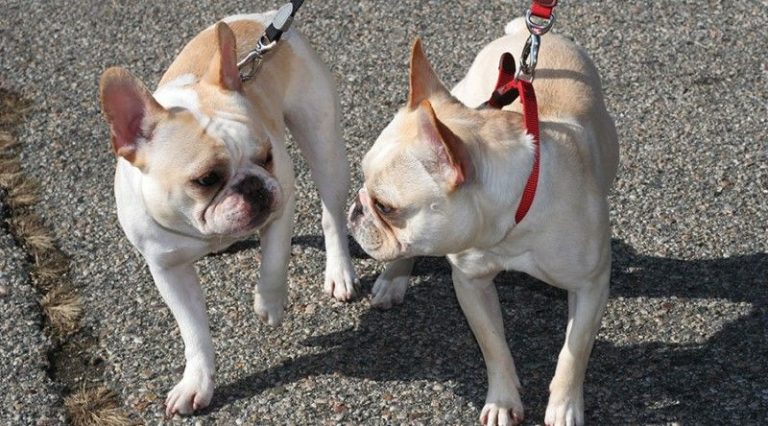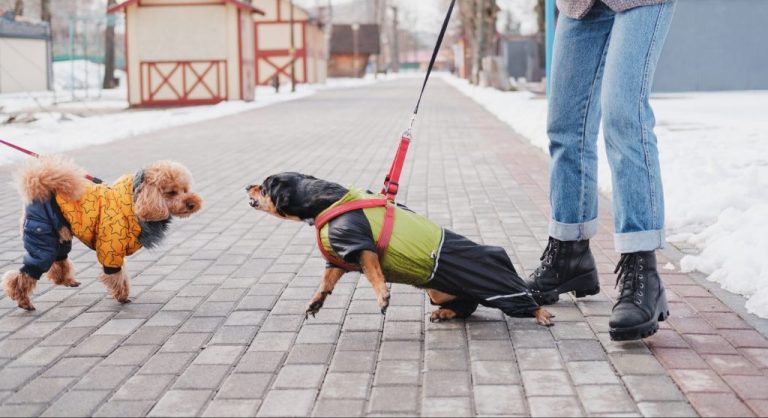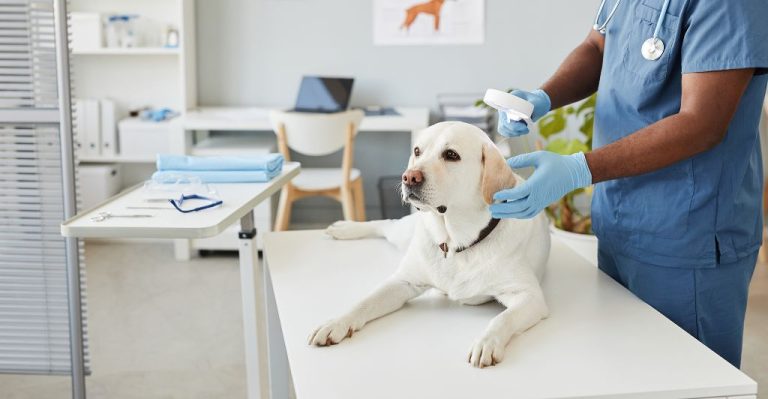Understanding Fearful Behavior In Dogs: Compassionate Training Approaches
What is Fearful Behavior in Dogs?
Fearful behavior in dogs is defined as an emotional response to something the dog perceives as frightening or threatening [1]. This fear or anxiety can be triggered by a variety of things, including loud noises, unfamiliar people or animals, new environments, separation from owners, and even objects or situations associated with a past negative experience [2].
Common signs of fearfulness and anxiety in dogs include cowering, hiding, trembling, panting, destruction, and inappropriate urination or defecation. Extremely fearful dogs may even act out aggressively by barking, lunging, or biting [1].
Fearful behavior can have a significant negative impact on a dog’s wellbeing and quality of life. Dogs with severe fears and phobias may experience ongoing distress, fail to adapt to new environments, have difficulty bonding with people, and struggle to enjoy normal dog activities like walks, car rides, or socialization [2]. Addressing the underlying causes is important for the dog’s welfare.
Why Do Dogs Develop Fears?
There are several key reasons why dogs may develop fears or phobias:
Lack of socialization – Puppies that are not properly socialized during their critical developmental stages often grow up fearful of things they were not exposed to. Socialization teaches puppies that new sights, sounds, smells, and experiences are safe. Without it, they may become fearful of anything unfamiliar.
Negative experiences – One bad experience like being attacked by another dog or getting scared by loud noises like fireworks can traumatize a dog and cause lasting fears. The memory of the negative event gets associated with whatever triggered it, causing the dog to react fearfully in similar situations. According to VCA Hospitals, dogs rescued from abusive homes often develop a fear of strangers, particularly men, after their experience.
Genetics/temperament – Some dogs are genetically predisposed to anxiety and fearful behavior. Breeds like greyhounds tend to be more sensitive and high-strung. Anxious parents can also pass on those traits to their puppies through heredity.
Common Fears in Dogs
Many dogs develop specific fears that can significantly impact their quality of life. Some of the most common fears seen in dogs include:
Strangers
Dogs who are fearful of strangers may bark, growl or hide when encountering unfamiliar people. This is often due to a lack of socialization as a puppy (Common Fears and Phobias in Dogs and How to Help).
Other dogs
Some dogs become fearful around other canines, especially unfamiliar ones. They may snap, bark or avoid interacting with other dogs when on walks or at the dog park (Common Fears and Phobias in Dogs).
Loud noises
Noises like fireworks, thunder, gunshots, or shouting can frighten dogs. They may tremble, hide, bark, or try to escape the noise (Common Fears And Phobias In Dogs).
New environments
Unfamiliar places like the vet’s office, groomer, or boarding facility can make some dogs anxious. They may seem hesitant, clingy, or unwilling to explore (Common Fears and Phobias in Dogs).
Objects/sights/smells
Things like umbrellas, hats, balloons, or costumes can frighten dogs. Strong odors or unusual sights may also trigger fearful reactions like barking, hiding, or aggression.
Long-Term Impact of Fear
Fear and anxiety in dogs can have detrimental effects over the long term. Chronic stress from ongoing fear responses takes a major toll on a dog’s health and wellbeing.
Studies show that the stress of living with severe fear and anxiety disorders can shorten a dog’s lifespan by up to 2.4 years (https://www.sciencedirect.com/science/article/abs/pii/S0168159110001243). The constant state of stress causes elevated cortisol levels, which weaken the immune system and damage vital organs over time.
Dogs suffering from frequent or intense fear responses are also more prone to developing other behavioral issues like aggression or separation anxiety (https://vcahospitals.com/know-your-pet/fears-and-phobias-in-dogs—animals-and-people). Their quality of life is greatly diminished as their world shrinks due to avoiding anything that triggers their fear.
Without proper treatment and desensitization training, fearful dogs miss out on many normal life experiences that are enriching and enjoyable, like going for walks, socializing with other pets, and more. Their fear prevents them from thriving and often leads to social isolation.
Assessing the Severity of Fear
When assessing fearful behavior in dogs, it’s important to consider both the intensity of the fear response as well as how generalized or context-specific the fear may be. There are three main categories used to classify the severity of fear in dogs:
Mild fear: Signs may include trembling, tail tucking, hiding, reduced activity, and passive escape behaviors. The dog is still capable of learning. (https://www.petmd.com/dog/conditions/behavioral/c_dg_fears_phobia_anxiety)
Moderate fear: Signs escalate and may include panting, whining, avoidance, and active escape behaviors. Learning may be impaired. (https://fearfreepets.com/resources/fear-free-store/fear-anxiety-and-stress-spectrum-dog/)
Severe fear or panic: Signs intensify further and may include freezing, frantic attempts to escape, and defensive aggression. The dog is unable to learn, listen, or respond. (https://vcahospitals.com/know-your-pet/fears-phobias-and-anxiety)
Fear may also be specific to certain contexts like strangers, loud noises, or car rides. Or it can be a more generalized anxiety where the dog feels fearful in many different situations. Assessing the triggers and patterns behind the fear helps determine the best training approaches.
When to Seek Professional Help
In some cases, a dog’s fearful behavior may become severe enough that professional assistance is needed. According to the Animal Humane Society, you may want to seek help from an applied animal behaviorist or certified dog trainer if your dog’s fear leads to aggression, becomes debilitating, or worsens over time (1).
Signs that your dog’s fear has become extreme include reactive or aggressive behavior like lunging, growling, or biting when faced with triggers. The Cornell University College of Veterinary Medicine also notes that trembling, hiding, running away, loss of bladder control, destructive behavior, and not eating are indicators of severe anxiety in dogs (2).
While every dog has a unique personality, most animals are adaptable and can become more confident with proper training and counterconditioning. However, some dogs’ fearful tendencies are so hard-wired that they have great difficulty overcoming them. If your dog’s reactions remain extremely fearful after months of gradual training, it may be time to consult an expert.
Professional trainers and behaviorists can assess the root causes of fear, design an individualized training plan, and provide methods to help fearful dogs thrive. They may also recommend anti-anxiety medication in some cases. Don’t hesitate to seek qualified help if your dog’s fears begin impacting quality of life.
(1) https://www.animalhumanesociety.org/resource/help-your-anxious-or-fearful-dog-gain-confidence
(2) https://www.vet.cornell.edu/departments-centers-and-institutes/riney-canine-health-center/health-info/fearful-dogs
Compassionate Training Approaches

The most effective approaches for training fearful dogs focus on compassion, patience, and gradual exposure therapy techniques such as desensitization and counterconditioning. The goal is to slowly change the dog’s emotional response and build confidence over time.
Desensitization involves gradually exposing the dog to the triggers that cause fear, starting at a very low intensity that does not evoke a fearful response. For example, if a dog is afraid of strangers, initial exposure would be to a stranger very far away. Slowly over many sessions, the stranger is brought closer as the dog remains relaxed. This allows the dog to learn the trigger is not dangerous.
Counterconditioning means changing the dog’s emotional response to the trigger by associating it with something positive. For example, giving the dog very tasty treats when people approach will help the dog associate strangers with good things. The dog begins to feel happy instead of fearful when strangers appear.
Confidence building focuses on providing positive experiences, teaching obedience cues, and encouraging exploratory behavior in safe environments. As the dog succeeds, their confidence grows. Training sessions should be short and end on a positive note to keep the dog’s stress low.
Having compassion for the fearful dog’s state of mind leads to more effective progress. Training fearful dogs requires immense patience. Some fears may take months or years to fully overcome. But by building confidence through compassionate techniques like desensitization and counterconditioning, fearful dogs can learn to face the world.
Medications
When behavior modification alone isn’t enough to improve a dog’s fearful or anxious behaviors, medications may be considered as an additional tool. It’s important to work with a veterinarian to determine if anxiety medication could be beneficial for your dog. The vet will take into account your dog’s health history, symptoms, and the severity of the anxiety before prescribing any medication.
Some of the most common medications used for canine anxiety include:
- Alprazolam (Xanax) – A fast-acting benzodiazepine often used for situational anxiety like thunderstorm phobia or separation anxiety. It works quickly but effects last just a few hours (1, 2).
- Amitriptyline – A tricyclic antidepressant sometimes prescribed for long-term generalized anxiety. It must be given daily and takes 4-6 weeks to reach full effect (1, 3).
- Buspirone – This non-benzodiazepine anti-anxiety medication is used for mild-moderate anxiety. It does not cause sedation and is given 2-3 times per day (2).
- Clomipramine (Clomicalm) – A tricyclic antidepressant approved for separation anxiety in dogs. It’s given daily and takes 6-8 weeks to work (1).
Some dogs may benefit from a combination of medications based on their specific symptoms. It’s crucial to closely monitor side effects and efficacy with any medication, working in partnership with your veterinarian. While drugs don’t cure anxiety, they may provide enough help for a dog to successfully engage in behavior modification training (1).
Creating a Secure Home Environment
A fearful dog needs a home environment that feels safe and minimizes stress triggers. Here are some tips for creating security:
Providing Safe Spaces
Dogs appreciate having their own dedicated space where they can relax and retreat when feeling anxious. This could be a crate, bed, or corner of a room. Place it in a quiet area away from high traffic and make it comfortable with blankets and toys (CCSPCA).
Allow access to this safe zone at all times, whether you’re home or away. Never use the space for punishment, so it remains a positive retreat.
Minimizing Triggers
Pay attention to things that seem to stress your dog like loud noises, strangers at the door, or being alone. Then take steps to minimize those triggers in their environment.
For example, provide background noise to drown out outside sounds or keep them in a separate room when guests visit. Maintaining consistency and predictability can also reduce anxiety.
Building Routines
Routines create stability for anxious pups. Feed, walk, and play at consistent times each day. Giving meals in puzzle toys can be calming. Stick to regular schedules for waking, potty breaks, and bedtime too.
Routines when leaving the house also help dogs with separation anxiety. Keep arrivals and departures low-key with minimal fuss.
Helping Fearful Dogs Thrive
Patience and compassion are key when working with a fearful dog. Fear is a very real and overwhelming emotion for dogs, just as it is for humans. Pushing fearful dogs too far or too fast can worsen their anxiety and set progress back. Go at your dog’s pace and celebrate even the smallest victories, like looking at a trigger from across the yard instead of immediately fleeing.
Focus on building confidence through reward-based training. Use high value treats to reinforce brave behavior and counter-condition the dog to associate triggers with something positive. With time and consistency, the dog will gain confidence. But some dogs may always be more timid than others, and that’s okay. The goal should be improving quality of life and helping the dog feel secure, rather than “fixing” the fear completely.
Some fears may require medications, supplements, pheromones, or other professional support. Keep working closely with your veterinarian and trainer. While slow, progress fighting fear is still progress. With compassion and patience, fearful dogs can learn to thrive in their forever homes.






